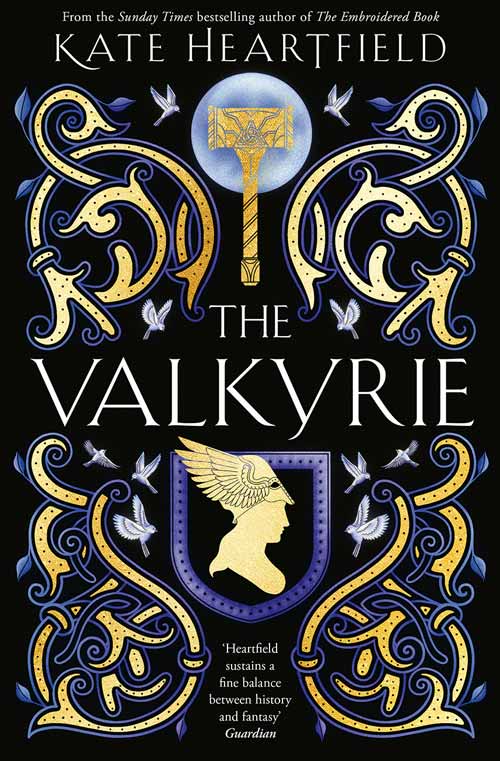Glamor and Darkness: Rosalie M. Lin’s Daughter of Calamity
 BY ELIZABETH K. CORBETT
BY ELIZABETH K. CORBETT
Rosalie M. Lin’s Daughter of Calamity (St. Martin’s Press, 2024) tells the story of Jingwen, a showgirl in Shanghai who works at the Paramount, a prestigious nightclub. When not competing with the other show girls at the club, she works as a money runner for her grandmother, Yue Liqing, who is a renowned surgeon. Among her grandmother’s clients are members of the Blue Dawn gang, the most powerful gang in Shanghai. Liqing wants Jingwen to one day take over her role, but she is not interested in doing so. When showgirls start getting attacked by an unknown assailant, she begins to fear for herself, and her life becomes far more complicated than it was before.
This story is set during the vibrant and dangerous world of 1930s Shanghai. Lin explains the complex social fabric of that time: “The 1930s in Shanghai was a glamorous time full of fashion, music, dance, and endless opportunity. However, beneath the merriment coursed a lot of shadows. Shanghai after the First Opium War was partitioned between eleven different nations, who forcibly opened the port city up for trade. The partitioning of Shanghai both allowed for more economic opportunity and growth—and more art and dancing—to come to Shanghai, but of course, the city was bound in metaphorical chains. I was fascinated by that stark contrast between the glamor and the darkness.”
The author tells us about her inspiration behind her debut novel: “I was inspired to write Daughter of Calamity when I was moonlighting as a pole dancer in Beijing, China, when I was in college. The history of Western-style nightclubs in China can be traced back to the early 20th century, around the time Daughter of Calamity takes place. One night I was out exploring some of the clubs in a “hipster” part of town, which meant the nightclubs were interspersed with ancient temples and ruins.”
She continues, painting a vivid picture of the old temples located next to nightclubs: “Compared to the flashing clubs throbbing with light and music, the temples lay silent—negative space whose only life was a wisp of incense that escaped between half-closed doors. I wondered, what do the ancient gods think of the nightclubs that have sprung up around their places of worship? Immediately, I thought of a story centered around a showgirl in 1930s Shanghai, the golden age of jazz and dancing in Shanghai, who one night enters an ancient temple beside the cabaret she dances in. And that was the seed for Daughter of Calamity.”
In the protagonist Jingwen, we have a young woman who is petty at the start of the story, but who ultimately grows. Since she lives in a dangerous world, she has no choice but to change in order to survive. Lin says: “I wanted her to start the story as a product of the brutal system that colonialist capitalism has created in Shanghai—the system is set up so that the various showgirls compete against one another for rich patrons to dance with. However, as she and the other characters grow, they eventually realize that they are stronger working together, and recognize each other as friends who have fought and survived the same trials and horrors of Shanghai.”
The author shares that one of her favorite characters is Yue Liqing. “Unlike Jingwen, who pursues a very feminine flavor of power that centers on beauty, dancing, and sexuality, Liqing grew up in a former era of China, where power for a woman meant striving to emulate notable masculine figures,” she explains. “Liqing trains very hard to become a notorious black market surgeon who makes silver limbs for Shanghai’s gangs. Liqing is so cool as a character to me, because she overcame great odds to achieve her position, although she is morally ambiguous and power hungry.”
Lin’s writing marries together the historical fiction and fantasy genres. Even though events occur in 1930s Shanghai, there is always an element of mythology and magic. Guanyin, a goddess in Chinese mythology, plays a prominent part in Daughter of Calamity. The author provides some background detail on this choice. “The bodhisattva Guanyin is perhaps the most well-known goddess from Chinese mythology in the west. She is the goddess of mercy and compassion who can often be found in temples and restaurant shrines, in China, regions touched by the Chinese diaspora, and perhaps local restaurants you might know. However, in Daoist mythology, she has a different identity as Xiwangmu, the Queen Mother of the West, who is actually a demon who finds enlightenment. When I visited various temples around China and the rest of Asia, I noticed that Guanyin and Xiwangmu are often styled differently—yet they are actually the same goddess!”

author photo by Natalie Jane Photography
She goes on to explain how Guanyin ties into the novel. “To me, this translation of a main mythological figure between two different religions was reflective of the same identity crisis faced by Jingwen in 1930s Shanghai—in a city where so many cultures overlap and clash, and Jingwen adopts a different personality/”mask” to interact with each population in Shanghai. Daughter of Calamity explores intergenerational trauma and how different generations react to the rapid westernization of Shanghai—we not only follow Jingwen’s journey, but also that of the oldest of Jingwen’s bloodline, who has been around since before Shanghai was born—Xiwangmu/Guanyin, the Mother of Calamity herself.”
Lin shares her own research process and how it has been incorporated into her book. “For me, it is the small, intricate details about history that makes a story come to life,” she says. “When I wrote Daughter of Calamity, I not only looked at historical sources about 1930s Shanghai written by westerners (which is almost all the hits you’ll get if you google the time period), but I wanted to highlight the perspective of the Chinese people themselves, which was largely missing from the body of English-language literature about the time period.”
She goes on to reference authors: “I read short stories from Chinese authors such as Mu Shiying and studied the postmodernist literary influences of his style. I also looked at the work of Yokomitsu Riichi, a Japanese author who wrote a book called Shanghai, about a group of disgruntled Japanese businessmen in Shanghai, also in the postmodernist style. These authors’ writing about the cabarets and nightclubs was infused with existential dread, atmospheric descriptions, and tangible sexuality—although they tended to be somewhat misogynistic. I strove to create a feminine, empowered version of the same “feeling” in Daughter of Calamity.”
About the contributor: Elizabeth K. Corbett is an author, historian, and book reviewer. Her short story “Marie-Thérèse Remembers” was published in 2022. She is the owner and operator of Reviews by Elizabeth K. Corbett, her personal website where she writes historical-centered book reviews. Based in coastal New Jersey, she enjoys researching local history and is currently working on her first novel.






